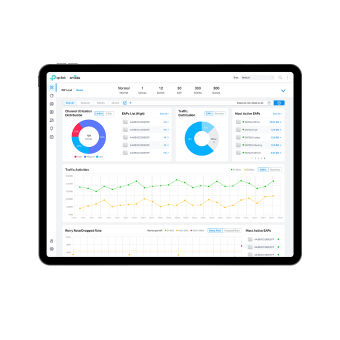How to configure the MSP Mode on the Omada Controller
Contents
Objective
The article describes how to configure the MSP mode on the Omada Controller and the functional changes that occur when it is enabled.
Requirements
- Omada Software Controller (v5.9 and above) / Cloud-Based Controller
Introduction
The MSP (Manager Service Provider) mode extends the management structure of the Omada Controller.
With MSP mode enabled, you can add multiple customers for higher-level management of sites and users. In MSP mode, you can monitor each customer's real-time status, manage all customers to oversee the entire network and handle all accounts.
The MSP mode is recommended for centralized management of sites and devices across different regions.
Enable MSP Mode
To enable MSP mode, follow the steps below:
Step 1. Log into the controller using the Main Administrator account.
Step 2. Go to the Global view, click the ![]() icon in the top right corner, and click Enable MSP mode. Confirm the action that appears in the dialog.
icon in the top right corner, and click Enable MSP mode. Confirm the action that appears in the dialog.

Note: Enabling or disabling MSP mode may disconnect cloud access or the Omada app, requiring you to log back into the controller.
After enabling the MSP mode, you will enter the MSP view by default.

Add and Manage Customers
In the MSP view, go to the Customer page.

You can add a customer in three ways:
- Add New Customer: Click Add New Customer above the Customer List, enter the Customer Name and Description, and click Confirm to add a new customer.

- Copy Existing Customer: Click the copy icon next to an existing customer entry, enter the Customer Name and Description, and click Confirm to copy the existing customer's configuration.

- Import Customer: Click Import Customer above the Customer List, fill in the Customer Name and Description, and decide whether to retain device information. Then, import the configuration file from a local file or file server.
Note: You can only import configuration files from Controllers with the same or smaller first three version numbers.

The new customer will be added to the Customer List, where you can view customer information and use the ACTION icons to edit, copy, delete, or log into each customer's controller.
Assign and Manage Licenses
Note: This section is only for the Omada Cloud-Based Controller.
Step 1. Go to License> Licenses. You can choose whether to enable Auto-Active and Auto-Rollover.
With Auto-Active enabled, the controller will automatically apply a license to a device once it is adopted.
With Auto-Rollover enabled, licenses will renew automatically upon expiration.
Auto-Active and Auto-Rollover work only when the customer has licenses.

Step 2. Go to License> License Assignment, click Assign Licenses in the top right, select the target customer, and assign licenses.

Add Sites and Devices
Step 1. Select the customer to log in from the Organization drop-down list in the top right corner. Create a site in the Global Dashboard.

Step 2. In the Global view or MSP view, go to Device > Known Devices to add devices.

Add and Manage Accounts
The system provides two levels of roles:
- MSP Role: for managing configurations in the MSP view
- Customer Role: for managing configurations in the Global view and Site view
Each role level has three default account roles: Main Administrator, Administrator, and Viewer. You can also create new account roles and customize their access permissions.
- Main Administrator
The Main Administrator can access all features in the corresponding view. The account that first starts the controller will be the Main Administrator.
- Administrator
Administrators can access most features in the corresponding view, but some modules are restricted. For instance, they do not have permission to perform customer migrations or automatic data backups, and they have view-only access to license management and custom account roles.
- Viewer
Viewers can view the status and settings of certain features in the corresponding view.
- Customer Role
Custom roles can be configured to access different features in the corresponding view.
To create a custom role, follow the steps below:
Step1. In the MSP view, go to Account > Role. On the MSP Role tab, click Add New MSP Role.

Step2. Specify the role type name and customize the permissions of the role. The MSP role is to manage configurations in the MSP view.

Step3. On the Customer Role tab, click Add New Customer Role. Specify the role type name and customize the permissions of the role. The Customer role is to manage configurations in the Global view and Site view.

Add New User
Step 1. In the MSP view, go to Account > User. Click Add New User.

Step 2. Specify the Username, Password, and TP-Link ID, and bind the user to the MSP Role and Customer Role according to your needs.

Conclusion
Now, you have configured the MSP mode to manage devices and accounts.
Get to know more details of each function and configuration please go to Download Center to download the manual of your product.
Чи була ця стаття корисною?
Ваш відгук допомагає вдосконалити цей сайт.









